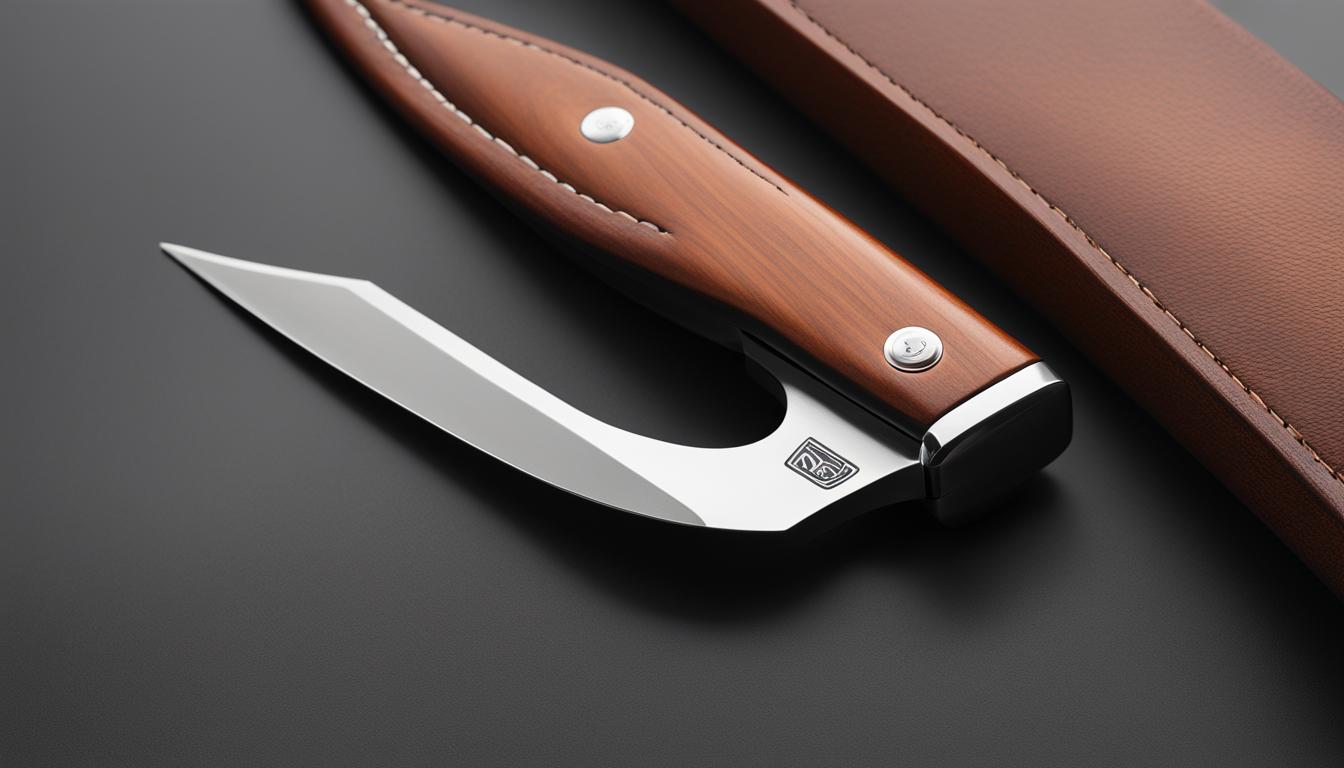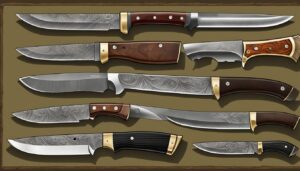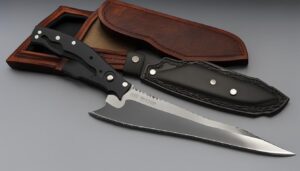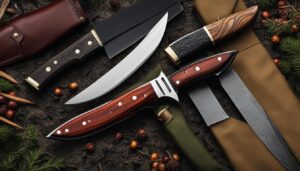In this article, I will delve into the fascinating world of hunting knives, specifically focusing on the evolution of their ergonomic designs. From ancient origins to modern applications, hunting knives have come a long way, adapting to the needs and preferences of outdoor enthusiasts, survivalists, and hunters. Join me as we explore the rich history and advancements that have shaped the contemporary hunting knife.
Key Takeaways:
- The fixed blade knife has a rich history and has evolved over centuries to become an essential everyday carry (EDC) item in modern times.
- Ancient origins of the fixed blade knife can be traced back to the Stone Age, where primitive tools made from materials such as flint and bone were used for hunting and butchering.
- Advancements in blade technology during the Iron Age led to stronger and more durable fixed blade knives, such as pattern-welded blades used by the Vikings.
- Modern fixed blade knives focus on durability, functionality, and ergonomics, catering to outdoor enthusiasts, survivalists, hunters, and those in need of a reliable cutting tool for various tasks.
- Ongoing innovations in fixed blade knives include improved blade steels, coatings, ergonomic handle materials, and customizable options like interchangeable handles.
Ancient Origins: The Beginnings of the Fixed Blade Knife
The fixed blade knife has a rich history that dates back thousands of years to the prehistoric era. Early fixed blade knives were crafted using materials such as stone, flint, obsidian, and bone. These primitive tools served multiple purposes, including hunting, butchering, and crafting other essential tools for survival.
One notable civilization that embraced fixed blade knives was ancient Egypt. The Egyptians used knives made of copper or bronze for ceremonial purposes and as symbols of power. These knives held great significance and were often placed in tombs alongside their owners as a mark of honor and status.
The ancient origins of fixed blade knives laid the foundation for their continued evolution and development. Over time, advancements in technology and the influence of various cultures have shaped the design, functionality, and significance of these knives in today’s modern world.
| Ancient Origins | Key Highlights |
|---|---|
| Prehistoric Era | – Fixed blade knives made from stone, flint, obsidian, and bone. |
| Ancient Egypt | – Copper or bronze knives used for ceremonial purposes and symbols of power. – Buried with their owners to signify honor and status. |
| Foundation for Evolution | – Ancient origins laid the groundwork for the continued development of fixed blade knives. – Technological advancements and cultural influences played a significant role in shaping their design and functionality. |
The Evolution: Advancements in Design and Functionality
The evolution of fixed blade knives has been marked by significant advancements in design and functionality. During the Iron Age, blade technology took a leap forward, resulting in stronger and more durable knives. The Vikings, renowned for their craftsmanship, used pattern-welded blades that combined multiple layers of iron and steel. These blades not only displayed intricate and artistic patterns but also offered greater strength and cutting power.
Various cultures around the world have played a role in shaping the evolution of fixed blade knives. They introduced unique blade shapes, handle materials, and decorative elements that reflected their traditions and needs. For example, the Nepalese Khukuri knife features a distinctive curved blade that is highly effective for both combat and utility tasks. Knife designs from Japan, such as the Tanto and Katana, showcase the country’s dedication to precision craftsmanship and functional beauty.
Advancements in design and functionality extend beyond the blade. Modern fixed blade knives incorporate ergonomic handle materials that provide a comfortable and secure grip, reducing hand fatigue during prolonged use. These handles are often designed with textured surfaces and contoured shapes for enhanced control and stability. Additionally, customization options have become more prevalent, allowing users to personalize their knives with interchangeable handles or add-ons such as lanyard attachments for easy access.
| Advancements | Design | Functionality |
|---|---|---|
| New blade steels | Unique shapes and patterns | Durability and cutting power |
| Ergonomic handle materials | Decorative elements | Comfort and control |
| Customization options | Personalized use and flexibility |
“The evolution of fixed blade knives has been driven by the pursuit of improved cutting performance, ergonomics, and aesthetics. Innovations in blade technology, handle design, and customization options have transformed these tools into versatile companions for outdoor enthusiasts and professionals alike.”
Advancements in Blade Technology
The advancement of blade technology has been instrumental in the evolution of fixed blade knives. Modern blade steels offer a balance of sharpness, durability, and corrosion resistance, ensuring that knives can withstand the rigors of outdoor use. Stainless steels like CPM-S30V and CPM-154 are popular choices for their excellent edge retention and resistance to rust. High-carbon steels, such as 1095, are favored for their ability to take and hold a razor-sharp edge.
Furthermore, blade coatings have become common in modern fixed blade knives. These coatings, such as DLC (Diamond-Like Carbon) and Cerakote, provide additional protection against corrosion and reduce glare, making the knife more discreet in tactical or survival situations.
Customization and Adaptability
One notable aspect of the evolution of fixed blade knives is the increased emphasis on customization. Many manufacturers offer a range of handle materials, allowing users to choose the one that best suits their preferences and needs. Popular options include G-10, Micarta, and carbon fiber, each with its own unique properties such as enhanced grip or exceptional strength-to-weight ratio.
In addition to handle customization, some knives feature interchangeable blade designs. This allows users to switch between different blade shapes, such as drop point or tanto, depending on the task at hand. The ability to adapt the knife to specific needs enhances its versatility and makes it a reliable tool in a wide range of outdoor activities.
The evolution of fixed blade knives continues to push the boundaries of design and functionality. With ongoing research and development, we can expect to see further innovations in blade technology, handle materials, and customization options. These advancements will ensure that modern hunting knives remain indispensable tools for outdoor enthusiasts, professionals, and anyone in need of a reliable cutting instrument.
Modern Application: The Fixed Blade Knife as Everyday Carry
Modern fixed blade knives have undergone significant advancements to make them practical tools for everyday use. With a focus on durability, functionality, and ergonomics, these knives have become reliable companions for outdoor enthusiasts, survivalists, hunters, and individuals in need of a dependable cutting tool for various tasks.
The everyday carry (EDC) movement has popularized fixed blade knives, with enthusiasts appreciating their reliability, versatility, and ease of access. Whether it’s camping, cooking, or self-defense, the modern fixed blade knife is designed to meet the demands of daily tasks. Its robust construction and sharp blade make it a valuable tool in a wide range of situations.
Advancements in materials and technologies have played a crucial role in shaping the modern fixed blade knife. Blade steels have improved to enhance performance and extend edge retention. Coatings provide added protection against corrosion, while ergonomic handle materials offer comfortable and secure grips, reducing slippage and minimizing fatigue during prolonged use.
Examples of Modern Everyday Carry Fixed Blade Knives:
| Brand | Model | Blade Length | Handle Material | Features |
|---|---|---|---|---|
| Benchmade | Tactical Fixed Blade | 4 inches | G10 | Full tang construction, sheath included |
| Ka-Bar | Becker BK2 | 5.25 inches | Grivory | Drop point blade, versatile utility knife |
| Spyderco | Street Beat | 3.5 inches | Kraton | Compact size, easy to conceal |
These examples highlight the variety of options available in the market, catering to different preferences and needs. As a popular choice for everyday carry, the modern fixed blade knife combines practicality, durability, and cutting-edge design to meet the demands of contemporary users.
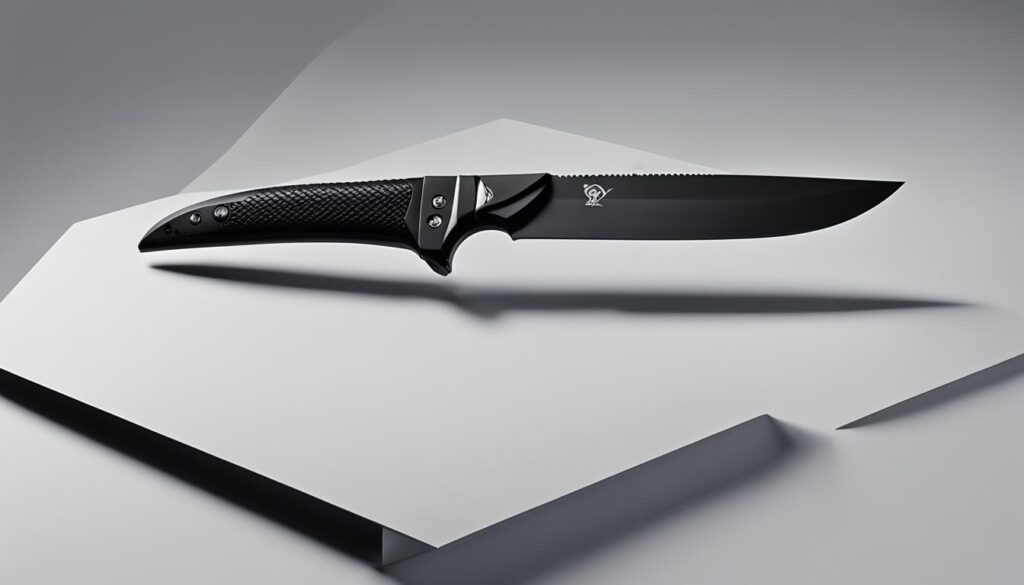
The Future: Innovation and Advancements in Fixed Blade Knives
The future of fixed blade knives holds exciting possibilities for innovation and advancement. As technology and materials continue to evolve, the design and functionality of these essential tools will further improve, catering to the needs of outdoor enthusiasts, survivalists, and hunters.
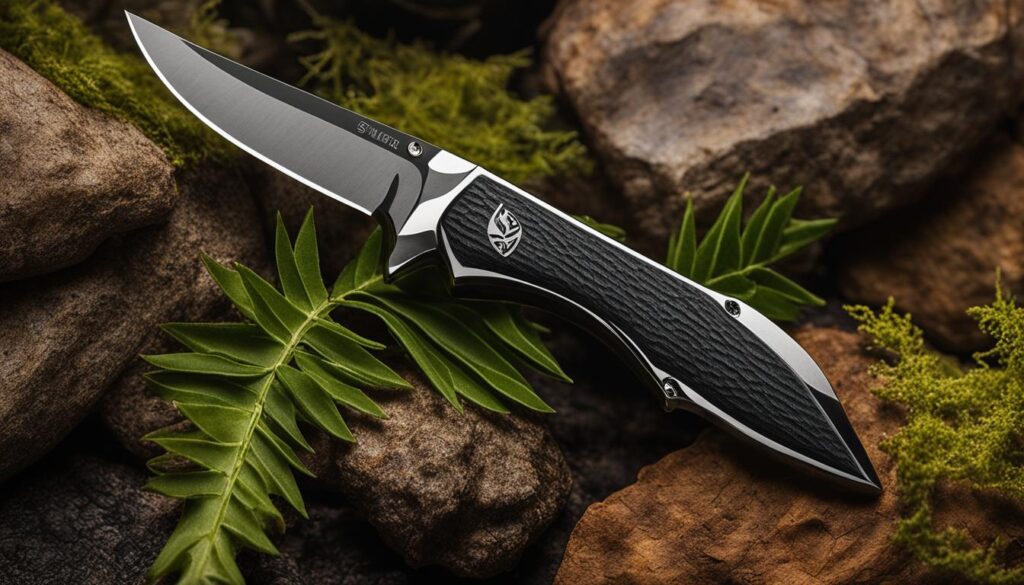

Advancements in blade steels and coatings will contribute to enhanced performance and usability. Manufacturers are constantly experimenting with new alloys and treatments to increase the durability, sharpness, and corrosion resistance of knife blades. These innovations ensure that fixed blade knives remain reliable and effective tools in any situation.
Ergonomics is another area that will see significant progress in the future. Knife handles made from advanced materials will offer improved grip and comfort, reducing slippage and minimizing fatigue during prolonged use. Customization options, such as interchangeable handles, will allow users to tailor their knives to their specific needs and preferences.
| Advancements in Fixed Blade Knives | Impact |
|---|---|
| Blade Steels and Coatings | Enhanced performance and usability |
| Ergonomic Handle Materials | Improved grip and comfort |
| Customization Options | Tailored knives for specific needs |
Sheath technology will also continue to advance, making it more convenient and discreet to carry fixed blade knives. Minimalist kydex sheaths and innovative retention systems will further enhance the accessibility and portability of these tools.
The future of fixed blade knives is bright, with ongoing innovation and advancements poised to revolutionize the industry. As new materials, technologies, and designs come into play, hunters and outdoor enthusiasts can look forward to a new generation of fixed blade knives that excel in performance, functionality, and ergonomics.
Exploring the Range: From Novices to Experts
Hunting knives cater to both novices and seasoned outdoorsmen, offering a range of options tailored to different skill levels and needs. Whether you’re just starting out or have years of hunting experience under your belt, there is a hunting knife out there for you.
For novices, entry-level hunting knives strike a balance between quality and affordability. These knives are designed to provide dependable performance without breaking the bank. With sturdy blades and comfortable handles, they offer a reliable tool for basic hunting tasks.
On the other end of the spectrum, advanced hunting knives are crafted with cutting-edge materials and designs specifically tailored to the rigorous demands of experienced hunters. These knives feature high-performance blade steels that offer a blend of sharpness, durability, and corrosion resistance. The handles are ergonomically designed to provide a comfortable and secure grip, reducing slippage and minimizing fatigue during prolonged use. Furthermore, advanced hunting knives often incorporate specialized blade shapes and edge profiles optimized for specific hunting tasks, such as slicing, skinning, and precision work.
Both novice and expert hunters can benefit from the versatility of modern hunting knives. These tools are capable of handling a range of tasks, from field dressing to wood cutting. With their full tang construction, hunting knives are built for durability and robustness, making them reliable companions in the wild. So whether you’re just starting your hunting journey or have been hunting for years, finding the right hunting knife can elevate your outdoor experience and enhance your performance in the field.
| Novices | Experts |
|---|---|
| Entry-level options | Cutting-edge materials |
| Affordable | Specialized blade shapes |
| Dependable performance | Ergonomically designed handles |
Conclusion
Hunting knives have come a long way in terms of design and functionality, particularly when it comes to ergonomics. Contemporary hunting knives prioritize user comfort and efficiency, ensuring that both novices and experts can rely on these essential tools for their outdoor activities.
The evolution of hunting knife designs has led to the development of ergonomic variations that cater to the diverse needs of users. With advancements in blade materials, handle designs, and customizable options, modern hunting knives offer enhanced performance and a tailored user experience.
From the sharpness and durability of the blades to the comfortable and secure grips provided by ergonomic handles, contemporary hunting knives excel in delivering functionality and durability. They are cherished by outdoor enthusiasts, survivalists, and hunters for their versatility in handling various tasks, from field dressing to wood cutting.
As we look to the future, we can expect further innovation and advancements in hunting knife designs. The ongoing focus on ergonomics, combined with continuous improvements in materials and customization options, promises even greater performance and user satisfaction in the years to come.
FAQ
What are the ancient origins of the fixed blade knife?
The fixed blade knife can be traced back to the Stone Age, where primitive tools made from materials such as flint and bone were used for hunting and butchering.
How have fixed blade knives evolved over time?
Advancements in blade technology during the Iron Age led to stronger and more durable fixed blade knives, such as pattern-welded blades used by the Vikings. Various cultures have influenced the evolution of fixed blade knives, introducing unique blade shapes, handle materials, and decorative elements.
What are modern fixed blade knives used for?
Modern fixed blade knives focus on durability, functionality, and ergonomics, catering to outdoor enthusiasts, survivalists, hunters, and those in need of a reliable cutting tool for various tasks like camping, cooking, or self-defense.
What innovations are happening in the world of fixed blade knives?
Ongoing innovations in fixed blade knives include improved blade steels, coatings, ergonomic handle materials, and customizable options like interchangeable handles. Sheath technology has also advanced, making it more convenient and discreet to carry fixed blade knives.
How long have fixed blade knives been around?
The fixed blade knife originated thousands of years ago in the prehistoric era. Early fixed blade knives were made from materials like stone, flint, obsidian, and bone. These knives served multiple purposes, including hunting, butchering, and crafting other tools.
What is the significance of fixed blade knives in ancient Egyptian culture?
Ancient Egyptians used fixed blade knives made of copper or bronze for ceremonial purposes and symbols of power. These knives were often buried with their owners as a mark of status and honor.
How have hunting knives evolved over time?
Hunting knives have evolved to become practical tools for everyday use. Advancements in materials and technologies have focused on durability, functionality, and ergonomics. Blade designs and handles have been optimized for specific tasks, such as slicing, skinning, and precision work.
What are the advantages of modern hunting knives?
Modern hunting knives prioritize ergonomics, functionality, and durability. Advances in blade materials, handle designs, and customization options enhance performance and user experience. They offer versatility for various tasks and are valued as essential tools by outdoor enthusiasts, survivalists, and hunters.
What does the future hold for fixed blade knives?
The future of fixed blade knives promises continuing innovation and advancements. Blade steels and coatings will contribute to enhanced performance and usability. Ergonomic handle materials and customization options, such as interchangeable handles, will allow users to tailor their knives to their specific needs and preferences. Sheath technology will continue to make carrying fixed blade knives more convenient and discreet.
Who are hunting knives designed for?
Hunting knives cater to both novices and seasoned outdoorsmen. Entry-level knives provide a balance of quality and affordability for beginners, while advanced hunting knives are designed with cutting-edge materials and designs tailored to the rigors of experienced hunters.
How have hunting knife designs improved?
Hunting knife designs have evolved to meet the needs of users, from novices to experts. Modern hunting knives prioritize ergonomics, functionality, and durability. Blade materials have evolved, offering a blend of sharpness, durability, and corrosion resistance. Handles are designed with ergonomics in mind, providing comfortable and secure grips, reducing slippage, and minimizing fatigue during prolonged use.
Source Links
- https://www.uniqueblade.com/pages/knife-handles-traditional-vs-modern-designs
- https://medium.com/@sexyrestful700/the-history-and-evolution-of-the-fixed-blade-knife-from-primitive-tools-to-modern-edc-d342d79007ab
- https://www.fuzia.com/article_detail/798309/hunting-knives-for-sale-redefining-the-art-of-the-hunt
